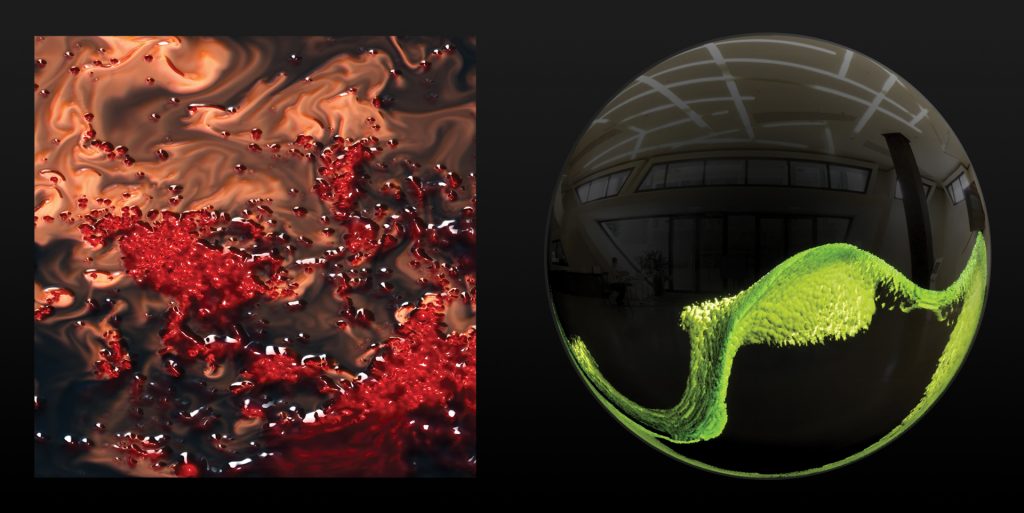
DïaloG, the First Aliens’ Encounter
DïaloG
The first Aliens’ encounter
2021
by Refik Anadol and Maurice Benayoun
Public art interactive installation,
Size to be adapted to the venue (usually 2-4m/screen).
2 Video displays (projection or LED screens) Sensors, AI, real-time generative graphics, behavioral design, voice recognition, text generation, sound.
Production: MoBen, Analog Native, Neuro-Design Lab, ACIM, SCM, CityU HK, MindSpaces S+T+Arts European Program, and MindSpaces HK, RGC HK
Première indoor for ART MACHINES 2 conference and exhibition,
June 10-20 2020,
School of Creative Media, Creative Media Center, CityUniversity of Hong Kong
Curators Tobias Klein, and Carlos Rodrigo.
short video: https://youtu.be/Ijm4FsgS-nw
360 video with an introduction by Maurice Benayoun
DïaloG is an interactive urban media art installation exploring the themes of alterity, strangeness, and immigration, in a performative way. The work presents two pieces that are at the same time artworks and aliens. They are confronted to a new environment where they don’t belong to… yet. They will have to adapt their language, build common knowledge, integrating all new artifacts and natural phenomena that constitute now their environment. This includes the other living beings moving around them, and, eventually, they will have to understand each other. While we use the concept of language very broadly to include speech, performance, gesture, utterance, and even data, we focus on strangeness from an ontological perspective, trying to mark a terrain of possibilities for the intersection of interpersonal and digital experiences in the urban sphere. MoBen and Refik Anadol take the notion of “dia-logos” (through-word, through speech) embedded in the etymological roots of the word “dialogue”, more understood as an informational thread processed through an iterative feedback loop between perception, and expression, and push it to a level of transactional complexity activating the potential difference between virtuality and visuality. In this way, we aim to create a unique, site-specific language between each of both works we are presenting as living entities and their unknown public, and also, between our works that are initially alien to each other – a language of unexpected and indefinable machine expressions that adapt themselves to the constant flow of data representing real-time environmental, societal, and human actions.
DïaloG is made of two “living” visual dynamic entities facing each other in the public space. They don’t look like the living beings we know. They don’t speak any language we know. They are aliens, strangers, immigrants. They are clearly – and desperately – trying to understand each other, to understand their new environment and their strange public. DïaloG reflects on the difficulty of building a mutual understanding beyond social and cultural differences. All that make living beings what they are: their morphology, their behavior, their ethology, and, beyond language, their cognitive functions make the laborious process of learning from strangeness and alterity a reality. Dotted with ever-growing perceptive and cognitive capacities, aware of its environment, the artwork is now able to adapt itself, to evolve and to communicate as would a more advanced living entity do. DïaloG tries to epitomize the emergence of the artwork as a subject, not only able to learn from its environment but also to dialogue with its public, and even, it may be a bigger challenge, trying to understand other artworks.
Contributions and history of the project
The DïaloG project stems from the authors’, Refik Anadol and Maurice Benayoun, respective practice in the field of generative art, that converge on this endeavor in the very context of the MindSpaces collaborative research project, “Art Driven Adaptive Outdoor and Indoor Design”, together with 12 different international partners, supported by the EU Horizon2020, S+T+Arts Lighthouse program.
- Center for Research and Technology (CERTH, project leader)
- Aristotle University of Thessaloniki
- Universiteit Maastricht (Belgium)
- Universidad Pompeu Fabra (Barcelona)
- McNeel Europe (Barcelona)
- UP2Metric (Barcelona)
- Nurogame (Koln)
- Zaha Hadid Architects (London)
- MoBen (Maurice Benayoun, Tobias Klein, Paris/Hong Kong)
- Analog Native (Refik Anadol, Germany /California, Sebastian Neitsch, Simon Weckert)
- L‘Hospitalet de Llobregat (Marta Borreguero-Ribo, Catalunia, Spain)
- City University of Hong Kong, School of Creative Media (Hong Kong SAR)
The project is also supported by HK RGC/EC joint program, through MindSpaces HK: Collective neuro-design applied to art, architecture and indoor design. School of Creative Media, City University of Hong Kong.
DïaloG is also supported by the School of Creative Media and ACIM fellowship through the Neuro-Design Lab.
Most of the partners contribute to different aspects of the research, from sensing technology and motion capture, architecture, neurosciences, data analysis and language treatment, space representation, and design, public behavior analysis…
The original project is to be presented on the specific site of Tecla Sala, under the umbrella of our institutional partner L’Hospitalet de Llobregat, Spain, (Marta Borregero), in collaboration with Espronceda (Alejandro Martin),
McNeel Europe (Luis Fragada), Pompeu Fabra (Leo Wanner, Simon Mille, Alexander Shvets), Maastricht University (Beatrice de Gelder, Alexia Briassouli), Zaha Hadid (Tyson Hosmer), CERTH-ITI (Nefeli Geor, Evangelos Stathopoulos…), Neuro design Lab SCM/CityU Hong Kong (Tobias Klein, Charlie Yip, Ann Mak, Sam Chan, Tim Leung, Tony Zhang, Lisa Park So Young)… Many others contribute actively to the project and the Art Machine 2 conference will be the first opportunity to present, validate and test the project in a concrete physical situation.
An early stage of development of the DïaloG project has been presented as an opening talk, Ars Electronica 2020 with a discussion between Refik Anadol and Maurice Benayoun, A Dialog about DïaloG, in the framework of the Ars electronica Hong Kong Garden where Ars Electronica attendees discovered the prospective generative work: Alien Life in the Telescope presented in real-time, online.








